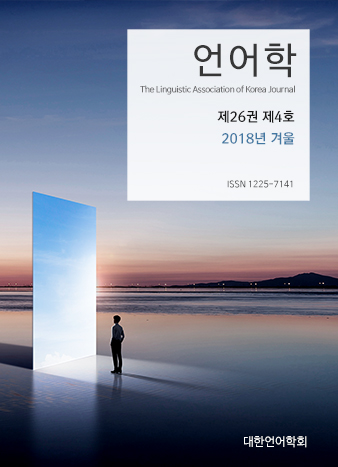대한언어학회 전자저널

-
L1 Interference in Koreans' Perception of Released Word-final Stops in English
-
Perceptual Similarity between English and Korean: Evidence from Online Adaptation
-
A Study on the Definite Article in English Based on the Rasch Model
-
Phonetic Resurrection from Ellipsis Sites: A Case from Pseudo-gapping
-
A Study of the Content Validity of Reading Comprehension Tests in NMET II
-
Labeling, Cartography, and the Left-periphery of Korean Clauses
26권 4호 (2018년 12월)
- 양 방향 강세 시스템(Bidirectional Stress Systems)의 재고
-
조혜성
Pages : 203-223
Abstract
Keywords
# 양 방향 강세 시스템(bidirectional stress systems) # 3-음절 강세 형태(ternary stress configurations) # 단어 내 lapse # 정렬 제약 # 3-음절 강세 창(three syllable stress window)
References
- 조혜성. (2017). 단어 말 두 음절의 강세 유형과 NONFINALITY 제약의 상관관계. 언어학, 25(4), 168-191.
- Alber, B. (2004). Clash, lapse and directionality. Natural Language and Linguistic Theory, 23, 485-542.
- Buckley, E. (1997). Optimal iambs in Kashaya. Rivista di Linguistica, 9, 9-52.
- Davis, S. (2005). “Capitalistic” vs. “Militaristic”: The paradigm uniformity effect reconsidered. In L. Downing, T. A. Hall, & R. Raffelsieffen (Eds.), Paradigms in phonological theory. Oxford: Oxford University Press, 107-121.
- Hayes, B. (1995). Metrical Stress Theory: Principles and Case Studies. Chicago: University of Chicago Press.
- Hyde, B. (2008). Bidirectional stress systems. In C. B. Chang & H. J. Haynie (Eds.), Proceedings of the 20the West Coast Conference on Formal Linguistics. Somerville, MA: Cascadilla Proceedings Project, 270-278.
- Jensen, J. T. (2000). Against Ambisyllabicity. Phonology, 17(2), 187-235.
- Kager, R. (2001). Rhythmic directionality by positional licensing. Paper presented at the Fifth Holland Institute of Linguistics Phonology Conference, University of Potsdam, January.
- Kahn, D. (1976). Syllable-based generalizations in English phonology. Unpublished doctoral dissertation, MIT, Cambridge, MA.
- McCarthy, J. (2003). OT constraints are categorical. Phonology, 20, 75-138.
- MacDonald, L. (1990). A grammar of Tauya. New York: Mouton de Gruyter.
- McCarthy, J., & Prince, A. (1993). Generalized alignment. Yearbook of Morphology, 79-153.
- Miller, W. (1996). Sketch of Shoshone, a Uto-Aztecan Language. In I. Goddard (volume editor), Handbook of American Indian Languages 17. Washington: Smithsonian Institute, 693-720.
- Prince, A. S. (1983). Relating to the grid. Linguistic Inquiry, 14(1), 19-100.
- Prince, A. S., & Smolensky, P. (1993/2004). Optimality Theory: Constraint interaction in generative grammar. Malden, MA and Oxford, UK: Blackwell.
- Steriade, D. (2000). Paradigm uniformity and the phonetic-phonology boundary. In H. van der Hulst & N. Smith (Eds.), Papers in Laboratory Phonology, 5. Cambridge, CUP, 313-334.
- Withgott, M. M. (1983). Segmental evidence for phonological constituents. Unpublished Doctoral dissertation, University of Texas, Austin.